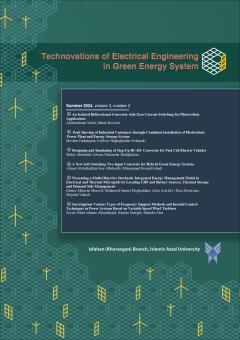عملکرد کاذب رله دیستانس در خطوط کابلی موازی شبکه فوق توزیع به علت اثر جریان معکوس خطا در راستای جریان بار
الموضوعات :فرهاد آقاجانیان صباغ 1 , فرزاد حاجی محمدی 2
1 - واحد مطالعات و تحلیل حوادث، امور دفتر فنی، شرکت اختر برق، اصفهان، ایران
2 - واحد مطالعات و تحلیل حوادث، امور دفتر فنی، شرکت اختر برق، اصفهان، ایران
الکلمات المفتاحية: عملکرد کاذب رله حفاظت دیستانس, خطوط کابلی موازی, شبکه فوق توزیع, زمین کردن شیلد کابل,
ملخص المقالة :
عملکرد کاذب رله دیستانس در سیستمهای قدرت الکتریکی ممکن است ناشی از مجموعهای از عوامل مانند، اشکال در سخت افزار یا نرم افزار رله، تنظیمات اشتباه و ... ایجاد گردد. در این مقاله موضوع عملکرد کاذب رله دیستانس در خطوط کابلی موازی شبکه فوق توزیع به دلیل پدیدهای سیستمی تحت عنوان "اثر جریان معکوس خطا در راستای جریان بار بر روی فاز سالم" از جنبههای مختلف مورد مطالعه و بررسی قرار میگیرد. نوآوری این مقاله تشخیص این پدیده میباشد که میتواند منجر به عملکرد کاذب رله دیستانس در یکی از فازهای سالم مربوط به خط سالم مجاور و در نتیجه قطع خط مذکور گردد. این در حالی است که خطا تنها بر روی یکی از دو خط کابلی موازی ایجاد شده و بایستی فقط همان خط معیوب از شبکه جدا شود. در این مقاله ابتدا این پدیده به طور کامل توضیح داده شده و اثر آن بر روی فازهای سالم خطوط موازی مجاور نشان داده میشود. سپس به منظور بررسی صحت پدیده مذکور، یک شبکه قدرت الکتریکی واقعی به کمک نرمافزار DIgSILENT مورد تجزیه و تحلیل و شبیه سازی قرار گرفته است. همچنین عواملی که باعث تشدید و یا تضعیف این پدیده میشوند مورد بحث و بررسی قرار میگیرد. در پایان راه حلهایی برای کاهش اثرات این پدیده جهت جلوگیری از عملکرد کاذب رله دیستانس ارائه خواهد شد.
[1] S. Salehimehr, B. Taheri and M. Faghihlou, “Detection of power swing and blocking the distance relay using the variance calculation of the current sampled data,” Electr Eng, vol. 104, no. 2, pp. 913–927, Jul. 2022, https://doi.org/10.1007/s00202-021-01350-1.
[2] B. Taheri, S. A. Hosseini, and S. Salehimehr, “An overview of power swing detection methods in distance relays and the factors involved,” IET Generation Transmission & Distribution, vol. 17, no. 4, pp. 743–761, Dec. 2022, doi: https://doi.org/10.1049/gtd2.12711.
[3] K. Seethalekshmi, S. K. Singh, and S. C. Srivastava, “A Classification Approach Using Support Vector Machines to Prevent Distance Relay Maloperation Under Power Swing and Voltage Instability,” IEEE Transactions on Power Delivery, vol. 27, no. 3, pp. 1124–1133, Jun. 2012, doi: https://doi.org/10.1109/tpwrd.2011.2174808.
[4] A. Thakallapelli, R. Mehra, and H. A. Mangalvedekar, “Differentiation of faults from power swings and detection of high impedance faults by distance relays,” in 2013 IEEE 1st International Conference on Condition Assessment Techniques in Electrical Systems (CATCON), Dec. 2013, pp. 374-377, doi: https://doi.org/10.1109/catcon.2013.6737530.
[5] S. Arasu and R. Ananthanarayanan, “Mitigating Distance Relay Maloperations during Load Encroachment through an Adaptive Mho Distance Relaying Scheme Based on Sequence Components,” SSRG international journal of electrical and electronics engineering, vol. 10, no. 9, pp. 40–60, Sep. 2023, doi: https://doi.org/10.14445/23488379/ijeee-v10i9p105.
[6] N. K. Rajalwal and D. Ghosh, “Superseding Mal-Operation of Distance Relay Under Stressed System Conditions,” Power systems, pp. 393–421, Sep. 2020, doi: https://doi.org/10.1007/978-3-030-54275-7_15.
[7] H. Mortazavi, H. Mehrjerdi, and M. Saad, “A Modified Load Encroachment Technique for Power Factor Monitoring,” 2018 IEEE Power & Energy Society General Meeting (PESGM), Aug. 2018, pp. 1-5, doi: https://doi.org/10.1109/pesgm.2018.8586366.
[8] T. Ghanizadeh Bolandi, M. R. Haghifam, and M. Khederzadeh, “Real‐time monitoring of zone 3 vulnerable distance relays to prevent maloperation under load encroachment condition,” IET Generation, Transmission & Distribution, vol. 11, no. 8, pp. 1878–1888, May 2017, doi: https://doi.org/10.1049/iet-gtd.2016.0486.
[9] A. Farid Bin Abidin and A. Mohamed, “On the use of voltage stability index to prevent undesirable distance relay operation during voltage instability,” in 2010 9th International Conference on Environment and Electrical Engineering, Jan. 2010, pp. 384-387, doi: 10.1109/EEEIC.2010.5489947.
[10] M. Sharifzadeh, H. Lesani and M. Sanaye-Pasand, “A New Algorithm to Stabilize Distance Relay Operation During Voltage-Degraded Conditions,” IEEE Transactions on Power Delivery, vol. 29, no. 4, pp. 1639-1647, Aug. 2014, doi: 10.1109/TPWRD.2013.2285502.
[11] M. Jonsson and J. Daalder, “Distance protection and voltage stability,” in 2000 International Conference on Power System Technology, pp. 971–976, Nov. 2002, doi: https://doi.org/10.1109/icpst.2000.897152.
[12] R. Cimadevilla and I. García, “Improvements in the operation of a distance relay during resistive faults,” in 2014 67th Annual Conference for Protective Relay Engineers, 2014, pp. 132-185, doi: 10.1109/CPRE.2014.6799000.
[13] A. D. Filomena, R. H. Salim, M. Resener and A. S. Bretas, “Ground Distance Relaying with Fault-Resistance Compensation for Unbalanced Systems,” IEEE Transactions on Power Delivery, vol. 23, no. 3, pp. 1319-1326, July 2008, doi: 10.1109/TPWRD.2007.909210.
[14] S. Zhu, Y. Xing and F. Sui, “Fault component reactance relay,” IEEE Transactions on Power Delivery, vol. 11, no. 3, pp. 1292-1300, July 1996, doi: 10.1109/61.517483.
[15] J. J. Grainger and W. D. Stevenson, Power System Analysis, McGraw-Hill, 1994.
[16] C. Russell Mason, “The Art and Science of Protective Relaying”, Wiley, 1956.
[17] G. Ziegler, Numerical Distance Protection, Fourth Edition, Publicis Erlangen, 2011.
[18] M. A. Ibrahim, “Disturbance Analysis for Power System”, John Wiley & Sons, 2012.
[19] Power System Relaying Committee of the IEEE Power and Energy Society, IEEE Std C37.113-2015, “IEEE Guide for Protective Relay Applications to Transmission Lines”, IEEE-SA Standards Board, 2015.
[20] Insulated Conductors Committee of the IEEE Power and Energy Society, IEEE Std 575-2014, “IEEE Guide for Bonding Shields and Sheaths of Single-Conductor Power Cables Rated 5 kV through 500 kV”, IEEE-SA Standards Board, 2014.


